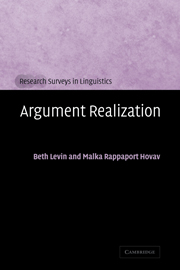Book contents
- Frontmatter
- Contents
- Acknowledgments
- Introduction
- 1 Challenges for theories of argument realization
- 2 Semantic role lists
- 3 Current approaches to lexical semantic representation
- 4 Three conceptualizations of events
- 5 The mapping from lexical semantics to syntax
- 6 Thematic hierarchies in argument realization
- 7 Multiple argument realization
- 8 Postscript
- References
- Index of topics
- Index of authors
- Index of languages
7 - Multiple argument realization
Published online by Cambridge University Press: 28 October 2009
- Frontmatter
- Contents
- Acknowledgments
- Introduction
- 1 Challenges for theories of argument realization
- 2 Semantic role lists
- 3 Current approaches to lexical semantic representation
- 4 Three conceptualizations of events
- 5 The mapping from lexical semantics to syntax
- 6 Thematic hierarchies in argument realization
- 7 Multiple argument realization
- 8 Postscript
- References
- Index of topics
- Index of authors
- Index of languages
Summary
As discussed in chapter 1, generative grammar traditionally assumed the realization of a verb's arguments to be determined by information registered in a structured lexical entry for that verb. In early versions of generative grammar, the syntactic expression of a verb's arguments is directly encoded in its lexical entry in the form of a subcategorization frame. Later, semantically based representations of argument-taking properties replace subcategorization frames (Bresnan 1982b; Marantz 1984; Pesetsky 1982; Rappaport and B. Levin 1988; Stowell 1981; Williams 1981), and the realization of a verb's arguments is calculated from these “argument structures” via mapping algorithms in ways illustrated in chapter 5. In Rappaport Hovav and B. Levin (1996, 1998a), we call such theories projectionist. There are a variety of projectionist theories which all share the fundamental assumption that a verb's lexical entry registers some kind of semantically anchored argument structure, which in turn determines the morphosyntactic expression – or projection – of its arguments.
In this chapter we consider a set of phenomena involving argument realization which pose a challenge to projectionist theories, the phenomena falling under the label multiple argument realization. Perhaps its most intensively studied manifestation is what we called argument alternations. This form of multiple argument realization is typified by pairs of sentences with the same verb, related by paraphrase or subsumption. The dative and locative alternations are illustrated in (1) and (2). A third alternation is illustrated in (3); as it lacks a conventionally accepted name, we refer to it as the with/against alternation (B. Levin 1993).
- Type
- Chapter
- Information
- Argument Realization , pp. 186 - 236Publisher: Cambridge University PressPrint publication year: 2005

